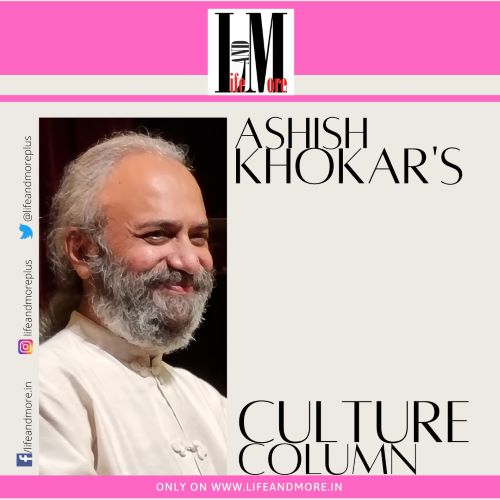FROM HEART ON ART

The year-end always becomes a time for stocktaking. This year let us examine where arts and culture is headed as a nation. Are we a nation? Or an assembly of different states, all knit together with one thread of being Indian. What is even Indian in India of today? Food, fashion or faltu things.
Faltu things: Weddings give employment to some and enjoyment to others but at what an expense?! An average wedding these days costs as much as a city flat. It depends on one’s pocket and desires how much one wishes to spend. When I look at some of the weddings post COVID, I feel a whole village could’ve been adopted for the same monies or 100 children given free education. Do we think of the good of society or self?
Goodness of deed and thought. Are we? Do we, as a race, do good deeds, or are we lost in caste and creed still? Do we feel proud that we are one, against all odds or are we divisive beyond repair?
Nationally what connects us all? Films. Actually, yes. We may lampoon some and treat others with “imposing Hindi on the rest of India” but films connect. Look at their outreach. Face familiarity. Nothing is more visible than film or TV stars. Even a news reader becomes a celebrity!
Arts are different. One has to prove for long, keep the fire going and strive for excellence. Painters have to paint; dancers have to dance to prove their worth. Art is also fragile. A broken finger and can one even play an instrument or a broken heart and best poetry can emerge. Art has low economic returns. How many artists are even solvent? COVID also paid put on any plans or savings.
The world being a stage, how many artistes get seen and celebrated? Where are the forums and opportunities? How much can the state do? Is the state doing enough? Are all our national arts bodies even aware of what artistes have been through or are going through? Are babus sensitive to artists? Does the system care?
Having watched the scene for 50 years consciously and conscientiously, I can say we have failed in public art. Look at our walls in cities, public spaces and even parks. Pathetic, mostly. Why? We don’t care or we don’t question? Why do we not question and accept third rate municipal management. Abroad parks are the first point of cultural activities. Winter or rain. In India, the best public maidans are a free for all.
Free art activity is also not a good sign for artists. Who pays? If the audience values arts, shouldn’t they pay? Fifty rupees is one hour parking in malls, and halls we sit in and enjoy art activities, we don’t want to pay even that? What’s 100 rupees today? Why can’t we pay that much for two hours of pleasure or change or sensitisation or escape from the humdrum of daily lives?
India needs cultural managers. Are we training enough to help run museums, archives and cultural properties? Babus may have cursory interest, but not lack core competency. They may be well meant but also easily swayed by camps and gangs in operation!
Corporate India. Oh, what’s that? They are not one bit involved with Indian culture. Period. Only industrial houses are, maybe the Tatas in an organised serious manner via say the NCPA or the upcoming Ambani Gio City and culture initiatives but did the average solvent corporate India support the arts? No. They have no interest and at best they do piece-meal or out of tokenism. One CEO likes paintings so he buys art and puts on office walls and that too becomes a company asset! Other loves modern dance or dancers! And maybe sponsors a show or two. That’s all. There’s no natural or neutral, sustained interest or support. Shame, shame!
So who then actually is interested? Other than the artists themselves, it is those Indians settled abroad who are actually the best patrons, possibilities and platforms. Pravasiya. Diaspora. Or a few foreigners who love things Indian. This constituency is the most solid support system for Indian artistes. Which is why most successful dancers or musicians have a base abroad to teach or perform for three to six months there. That’s where they also earn daaaalluurrs! With which they return to India and build another room or house or buy a car or life.
Life ain’t fair all the while. Let’s make what is possible of it, now. May the new year be indeed new in thought and deed. Do something for the arts in your locality, city, state. Sponsor a child artist; buy a little painting. A book. Support a dance show or what you like. Host a lecture. Be alive. You are giving a value addition to life itself.
Happy New Year!
Ashish Mohan Khokar is an artivist too, raising questions and issues that help society. This after 45 books and
5,000 articles in mainstream media in last 40 years of writing, teaching, filming, mentoring makes him the
most original voice in dance documentation field. A historian, backed with proof and academics,
he is hailed as the gold standard of Indian dance heritage writing.




2 Comments
Ashishji’s article raises very important questions bringing awareness to us as a society and sensitising us as individuals.
well said, though certainly not a new situation. Sanjukta Panigrahi, the greatest Odissi dancer after our guru, Kelubabu, only actually earned when she spent a good chunk of time abroad at the height of her career, the rest was making Odissi known throughout India with minimal earning til she spread the art abroad.